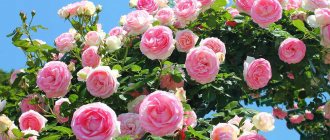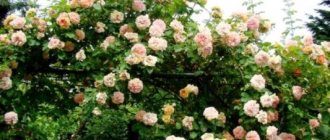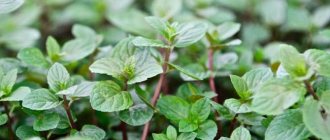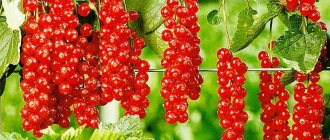Blooming all summer
Garden shrubs that bloom from spring to late autumn are always popular with gardeners.
Rosa rugosa (rugosa)
Rugosa belongs to the Rosehip genus. This is the most popular variety of perennial shrub, blooming all summer and autumn.
The plant is powerful, the stems are erect. The height can reach 2.5 m. A distinctive feature is leaves with deep veins that give the appearance of wrinkles. The most intense flowering is observed in June. Some varieties bloom until the first frost. The shades of the buds are most often bright pink, but white and purple-red are also found.
Rugosa is hardy and frost-resistant, has high immunity to disease, and is unpretentious in care. Easily withstands frosts down to -30 °C and below. Watering is only required during severe drought. Feeding is necessary once every 3 years, starting from the third year of the plant’s life. At the same time, sanitary and shaping pruning of the bushes begins.
Buddleya
Honey tree, autumn lilac, butterfly magnet - this is also called buddleia. The height of the flowering bush can reach three meters. The stems are thin and erect. The bushes themselves are spreading. Foliage color ranges from light to dark green with a silvery tint. Buddleia flowers are small, collected in balls or panicles, reminiscent of lilacs. The color of the buds is often lilac, but pink, yellow, red, orange, and less often white inflorescences are found.
The flowering shrub is unpretentious in care. However, in shaded places it blooms sparingly and grows poorly. In the Urals and Siberia it freezes completely; it can only be grown as an annual or in the winter garden as a bright plant that blooms all year round. Rarely survives winters in the Moscow region and Leningrad region, even with good shelter. After freezing, it is restored within two years.
Hydrangea
Another variety of perennial shrub that blooms all summer. Bushes in good conditions grow up to 2 meters in height. Stems are strong and erect.
Hydrangea leaves are large, green, with prominent veins. The flowers are oval-shaped, up to 30 cm in diameter. The color is most often white.
The shade of hydrangea flowers directly depends on the pH of the soil. In acidic soil the flowers are blue, in alkaline soil they are pink or lilac, and in neutral soil they take on a pale beige hue.
Hydrangea is unpretentious in care. But without proper watering, the number of flowers decreases sharply. Does not like drafts and strong midday sun, due to which the inflorescences lose their brightness. An adult shrub overwinters without shelter at -30 °C. Young plants can die as early as -5°C, so they should be covered for the winter.
Mackerel leather
These long-flowering garden shrubs are native to North America. Skumpia gained popularity due to the unusual color of the leaves and broom inflorescences. The stems of the bushes are erect, the height of the plant can reach three meters.
Depending on the variety, mackerel leaves are green, purple, orange, red, and golden.
In order for the scumpia to maintain its spectacular appearance, it must be trimmed in time and the crown formed.
Flowering shrubs need a lot of space, so you shouldn’t plant anything within a radius of two meters. Water the mackerel as needed. The plant can withstand frosts down to -30 °C, but in regions with prolonged cold it is necessary to provide shelter.
Cinquefoil bush (Kuril tea)
One of the most unpretentious perennial shrubs, blooming all summer and autumn. The plant can grow up to 1.5 m in height. Thin, highly branched stems gather into a dense spherical crown. Flowering is abundant and interchangeable. Some buds are fading, others are just blooming.
Cinquefoil loves places with sparse light. In the shade it loses its decorative qualities and fades in the sun. The flowering shrub loves moisture and needs frequent watering, especially in hot weather.
The culture is frost-resistant and can withstand temperatures down to -45 °C. Therefore, you don’t have to worry about sheltering for the winter.
Spiraea japonica
An undemanding deciduous shrub with beautiful inflorescences. Spiraea is often used to create hedges, borders and long-flowering landscape groups. Small buds of white, pinkish or purple hue are collected in lush brushes or shields on the tops of strong stems.
Spiraea grows quite chaotically, so it needs formative pruning. Mature bushes reach a height of 100 cm; dwarf varieties have been bred for flower beds that grow up to 50-60 cm. They can be used for ground cover plantings. Summer spireas bloom from late June to mid-August.
Shrubs for low-light areas
For shaded areas of the garden, it is recommended to choose shade-loving ornamental flowering bushes. The lack of sun does not prevent them from growing and blooming profusely.
Rhododendron
The shrub is called a rose tree because of the similarity of the buds to roses. Large (up to 20 cm in diameter) flowers are collected in inflorescences or brushes. The range of shades is wide and depends on the type of perennial. The shape of the leaves and their size also depend on the variety of rhododendron. The stems of the plant are erect.
Rhododendron prefers shaded areas and acidic soil. The roots are located close to the surface of the earth, so you should remove weeds with your hands. You need to water the shrub as needed - excessive moisture leads to rotting of the roots. Evergreen rhododendrons are not frost-resistant; deciduous ones (azaleas) are more viable.
Elder
This unpretentious perennial is characterized by high frost resistance (up to -45 ° C) and is not affected by pests and diseases. The plant can reach 6 m in height. The shoots are erect, some slightly droop under the weight of the fruit. Young branches are green with soft skin, mature branches are gray-brown with rough bark with numerous scales. The leaves are large, the shape and size depend on the plant variety.
Small elderberry flowers are collected in corymbose inflorescences and have a pronounced aroma. Flowering occurs in May-June, in the northern regions in June-July. After flowering, fruits form on the branches.
Elderberry does not require special care. Grows well in the shade and in poor soils. Watering, weeding and loosening the soil are carried out as necessary.
Kerria (Japanese rose)
A beautiful flowering shrub up to three meters in height is grown as a perennial only in the center and south of Russia. The stems are long, twig-like, green in color. The flowers are about 4.5 cm in diameter. They can be terry or simple. The beginning of flowering depends on the region of growth. Lasts 3.5 weeks. In autumn, kerria blooms again.
The culture loves places with sparse lighting, loamy soils and abundant watering. Sanitary and formative pruning is desirable. Flowering shrubs are fed twice a season: in the spring with organic matter, in the fall with ash.
Luxurious clematis
Perennial decorative vines that are suitable for creating flower beds of continuous flowering. The length of the lashes reaches 8-10 meters. The flowering period lasts from late May to autumn, so clematis has become a popular plant for vertical gardening of hedges, gazebos and ridges.
There is also a semi-shrub form up to 60 cm high. Simple and double inflorescences reach a diameter of 17-20 cm. The flower is formed from a rosette of sepals with a dense bunch of pistils and stamens. At the height of flowering, clematis looks like a flower blanket.
Shrubs for cold regions
Frost-resistant ornamental flowering shrubs thrive in cold regions of the country.
Syringa
Mock orange or garden jasmine grows well in climate zones 2 and 3. Tall varieties of perennials can reach three meters in height, while low-growing varieties do not exceed 100 cm.
Most plants have erect, twig-like shoots, but there are twining and drooping ones. The flowers have a regular shape, often collected in clusters.
Jasmine grows well in shade and sunlit areas of the garden. But summer residents say that the aroma is brighter in shaded areas.
Mock orange needs additional watering only in severe drought. It responds to feeding with abundant flowering. Weeding, loosening the soil and pruning are performed as necessary.
Derain white
Another name for the shrub is variegated derain. One of the most popular perennial plants for the northern garden. The central stems grow upright, the lateral ones bend towards the ground. In nature, the shrub can reach 3 meters in height.
Flowering begins in May-June - small creamy-yellow flowers densely cover the bush. In winter, the foliage turns burgundy.
Derain is unpretentious in care. Grows in shaded and sunny places, on any soil. Frost-resistant, does not require shelter for the winter. To be on the safe side, young bushes can be covered with a thick layer of snow. Every 2 years the bush is pruned to preserve the brightness of the bark.
Snowberry white
Of the 15 species of this flowering shrub, only white snowberry has adapted to the harsh climatic conditions of Russia. The plant can withstand temperatures as low as -35 °C without shelter.
The height of the ornamental plant for the garden is 1.5 meters. The shoots are flexible, the leaves are small and elliptical in shape. The flowers are small, bell-shaped, pale pink or white. Flowering begins in the second half of summer and lasts about a month. At the beginning of autumn, snow-white fruits with a diameter of about 1 cm appear on the snowberry patch. The fruits hold tightly to the branches even in winter under a layer of snow.
The fruits of the snowberry are beautiful, but poisonous. They cannot be eaten.
The shrub is drought-resistant - in hot summers it is enough to water it once a week. In spring, you can prune damaged shoots and give flowering bushes a neater shape.
Barberry
Heat-resistant and frost-resistant perennial barberry is beautiful during the flowering period and in the fall, when the fruits appear and the leaves acquire red and yellow shades.
Depending on the species, barberry can be deciduous or evergreen. The height of the plant ranges from 60 to 250 cm. The shoots are ribbed and erect. The leaves are small in size, growing on short petioles in bunches of 3-6 pieces. Yellow flowers form clusters of 6-10 buds. They bloom in May. The fruits ripen in September.
Agricultural technology for barberry is standard - weeding, loosening and watering are carried out as necessary. There is no need to cover barberry for the winter. Pruning and crown formation are carried out in the spring months.
Bladderwort viburnum
This flowering perennial shrub comes in two forms - with purple and with golden leaves. Plant height up to three meters. The shape is fountain-shaped and spreading. The leaves are large.
Flowering begins in June and lasts until August. The buds are small, white, the inflorescences are collected in “caps”. After flowering, fruits appear in the form of bubbles. At first they are green, and in the fall they turn dark burgundy.
Bladderwort is an unpretentious flowering shrub. Loves the sun, but grows well in the shade. Frost-resistant, does not require shelter for the winter. Crown pruning is performed in early spring, removing old, damaged and diseased branches. Decorative molding can be done from the age of 3.
Every 5 years, the bladderwort is cut off almost at the root, leaving 20-centimeter stumps.
Spirea
There are many varieties of spirea. There are both low-growing (15 cm) and tall (up to 2.5 m) perennials. Branches can be erect, spreading, recumbent or creeping. The inflorescences are pyramidal, paniculate, corymbose or spike-shaped and consist of small flowers.
The color range is varied - from snow-white to crimson. In different species, inflorescences can be concentrated in different places - at the ends of branches, in the upper part, along the entire stem.
Spiraea can be spring-blooming or summer-blooming. Most spireas grow in both sunny and shaded areas. The flowering bush is winter-hardy and does not require shelter even in the Siberian winter.
Spiraea loves frequent but moderate watering and nutritious soil. For fertilizing, both complex mineral fertilizers and manure fertilizers with the addition of superphosphate are used. Mandatory measures for caring for a flowering bush are loosening and pulling out weeds.
Humble Heather
Ground cover herbaceous shrub with evergreen foliage. The stems reach a height of 50-100 cm. Under natural conditions it creates vast heather wastelands. The flowering period lasts from June/July to August. The upper part of the shoots is covered with many goblet-shaped buds of white, lilac or cherry hue.
Dry petals remain on the stems for several more weeks, continuing to decorate the area. Heather varieties differ not only in their flowers and habit, but also in the color of their leaves - they can be green, yellow, red or bronze.
How to choose a shrub for your site
If you plan to carry out landscaping on your own, without the help of a specialist, then you should choose proven flowering shrubs that are suitable for the climate of the area.
Before purchasing plants, you need to pay attention to the following properties:
- Appearance of the shrub: height, splendor, shape of leaves, flowers and berries, the ability to shape the crown to your liking, compatibility with other flowering shrubs in the garden;
- Time and duration of flowering. When purchasing, it is necessary to take into account seasonal changes in the appearance of flowering shrubs;
- Features of caring for shrubs. If agricultural practices are incorrect, the plant will quickly lose its decorative properties.
With the right choice of plants for the garden, bright flowering bushes will delight the owner with their beauty all year round. It is important to take into account climatic features and cultural characteristics. And also do not forget that even the most unpretentious flowering plants need care and attention.
Tips for creating a presentable garden
Now you know which shrubs bloom throughout the summer. To create a harmonious design of the garden area, you just need to successfully select the varieties of flowering vegetation. First of all, you should find out whether plants that bloom for a long time are suitable for the existing climatic conditions.
It is also important that shrubs planted in the same zone have identical care requirements. Taking these points into account, it will be easier for you to select soil and organize irrigation.
Advice: give preference to presentable perennial shrub vegetation that retains its aesthetic appearance for several seasons. It is optimal for plants to decorate the site all year round.
The beauty of the garden area must be maintained both with the help of variegated flowering shrubs and with lush plants with beautiful leaves that have a neat compact shape.
To decorate your summer cottage, use fruit-bearing vegetation that can diversify the appearance of the green area. A number of varieties of shrubs retain their attractiveness even after the leaves have fallen.
Such plants perform not only a decorative function: they can also be used for practical purposes, for example, to create a presentable hedge, for zoning an area, or focusing on certain elements of landscape design.
When creating a stone and plant composition - a rock garden - we recommend that you familiarize yourself with what plants can be planted for an alpine hill: photos and names, recommendations and subtleties of selection and planting are described in the article.
Read about how to set up a nice mini-pond in your dacha here.
What applies to small architectural forms of improvement? Read more about MAFs on the site in the article at:
Using such plants, you can transform the appearance of existing buildings on the site. But to get the most successful result, you need to have a good understanding of the types of shrub vegetation that are suitable for the garden and bloom throughout the warm period. Study the planting and care rules provided for such shrubs.
You can also use ready-made schemes for combining flowering shrub plants, explore new ideas for landscape decoration, and use them to create a spectacular and stylish garden design.
Decorative honeysuckle
An evergreen liana from the Caprifoliaceae family. Adult shoots reach a length of 5-6 meters. Flower honeysuckle is suitable for growing in temperate and mild climates. Bright buds are collected in groups at the tops of young stems.
The flowering period lasts all summer. The inflorescences are delicate openwork with two-color and contrasting petals. In place of the buds, bright small berries ripen, which look beautiful against the background of smooth green foliage.
The selection includes ornamental shrubs with a long flowering period. The selected plants are distinguished not only by their beautiful buds, but also by their simple growing conditions. With a small investment of time, they will turn the site into a picturesque spectacle throughout the summer months.
Climbing (climbing) rose
A variety of roses with thin vines up to 15 meters long. On a support, the plant creates beautiful figured arches, columns and hedges. Varieties with creeping shoots are used as a ground cover crop. Roses should be planted in sunny parts of the site with good lighting. They respond well to watering and fertilizing.
The flowering period lasts from several weeks to three months. The average size of a blossomed bud is 8-10 cm. The colors are varied: white, pink, cherry, blue and orange. New shoots grow constantly, so in a comfortable climate, roses can bloom for up to six months. For the winter they need good insulation.









![Tinkoff (Debit card) [CPS] RU](https://adzumi-sushi.ru/wp-content/uploads/tinkoff-debetovaya-karta-cps-ru41-330x140.jpg)

